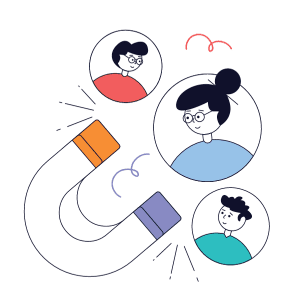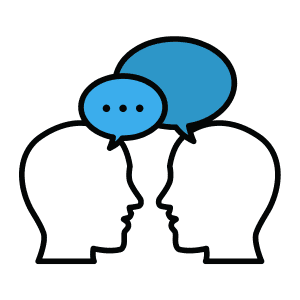How to Improve Client Retention & Keep Them Happy
Keeping clients happy and retaining them is a crucial part of running a business. It costs approximately five times more to find new customers than to retain a current customer. Keeping great relations with all of your clients can lead to many opportunities for your business, whether that be referrals, more company exposure, or new leads.
It takes a long time to build credibility within your industry, but a few bad reviews can leave your company with no business. Client retention should be top of your list as a business owner.
What is Client Retention?

Customer Satisfaction:
Ensuring that customers are happy with the products or services offered. This can be achieved through high-quality products, excellent customer service, and addressing customer needs effectively.
Loyalty Programs:
Implementing programs that reward customers for their continued business. These can include discounts, special offers, or loyalty points.
Regular Communication:
Keeping in touch with clients through newsletters, updates, or personal outreach to keep them informed and engaged with the brand.
Feedback and Improvement:

Personalization:
Tailoring the customer experience to individual needs and preferences, which can increase customer satisfaction and loyalty.
After-Sales Service:
Providing support after a purchase has been made to resolve any issues and ensure customer satisfaction.
Why is Client Retention Important?
The simple fact of the matter is that client retention is important from a financial standpoint. The cost of acquiring new customers is much higher than retaining existing customers – almost 5 times higher!
Not only that but for businesses that rely on repeat business, the success rate of selling to a customer you already have is 60-70%, while the success rate of selling to a new customer is 5-20%! There is a direct link between high client retention and increased profits. Increasing customer retention by 5% can increase profits from 25-95%!
So, how can you actually improve client retention at your organization?
How to Improve Client Retention
The obvious way to retain your clients is to provide great products/services. However, there are many other factors that go into client retention just as we mentioned above!
Loyalty Programmes
If you’re a product provider, it is easy for you to create and maintain loyalty programmes. You can offer discounts/free products after “x” amount of purchases etc.
Rewarding loyalty in service industries can be a bit more nuanced compared to product-based industries, as the focus is on the quality and personalization of the service experience. Here are some effective ways to reward loyalty in service industries:
- Tiered Loyalty Programs: Create a loyalty program with different levels or tiers, where customers can earn rewards based on the frequency or volume of their service use. Each tier can offer increasingly valuable benefits, such as priority scheduling, exclusive access to certain services, or special discounts.
- Personalized Services: Offer personalized services as a reward for loyal customers. This could include custom-tailored services, priority access to new services, or special accommodations based on the customer’s preferences and history.
- Exclusive Offers and Discounts: Provide loyal customers with exclusive offers, discounts, or special pricing for continued or extended use of services.
- Complimentary Upgrades or Add-ons: Reward frequent customers with complimentary upgrades (e.g., a higher level of service at no extra cost) or free add-ons that enhance the service experience.
- Recognition and Appreciation Events: Host special events, webinars, or workshops exclusively for loyal customers. These events can be both a way to show appreciation and an opportunity to provide additional value and engagement.
- Referral Incentives: Encourage loyal customers to refer new clients by offering them incentives or rewards for every successful referral. This not only rewards the loyal customer but also helps in acquiring new clients.
REGULAR COMMUNICATION
Any channel of communication that your company can regularly use with their clients will go a long way for a positive relationship. Communication can occur every week, biweekly, or even every month. Just talking to your clients on a regular basis will indicate that you keep the client’s company in your mind often.
Over-communication is better than no communication. If the client is kept up to date on the current project, they will be more inclined to trust you. Your client should know why they are paying money to your company for your services! Also, find a communication channel that suits you and your client’s needs.
Whether that be by phone, email, or messaging service, try to find something that is convenient and mutually beneficial.
BE RESPONSIVE
Responding to emails and or social media messages is a core piece of communication that is overlooked often. Sometimes, people read an email and forget or don’t even respond to it. These mistakes must be avoided to keep at least a cordial relationship with your client. Typically, the maximum limit you should respond to an email is 24 hours.
A survey by MailTime.com revealed that 52% of people who send a work email expect a response within 12-24 hours. A quick response can show that your company cares about its clients and that if something urgent were to come up, your company would be there to respond rapidly.
The same goes for any outreach from the customer – particularly if they are facing an issue. Your reaction to issues is often more telling than getting something right in the first place.
BUILD RELATIONSHIPS
Wanting to know about your clients can seem a little intrusive, but not if you do it right. Building genuine relationships helps instill a sense of trust and familiarity between your company and your client. You can build relationships through several simple things such as knowing about your client’s current projects, their family, and their interests.
Always putting on a business front every time you meet clients is not necessarily a positive aspect. You should be able show a bit of personality as well! Clients usually like working with a person who shares the same values or similar lifestyles.
In addition to knowing these simple things, you can also celebrate anniversaries, such as your client’s one-year company anniversary. Sending handwritten Christmas cards and thank-you notes can also help your company be top of mind for your clients.
Seek Feedback & Utilize It!
Asking for feedback can be a powerful tool. Instead of conducting market research and wasting time and money, you can just ask your clients for feedback! According to Chief Outsiders, 70% of unhappy clients turn into brand advocates if a mistake is fixed beyond their expectations. Here’s why it’s so important:
- Understanding Client Needs and Expectations: Feedback provides direct insights into what clients expect from your services or products. Understanding these needs and expectations is crucial for tailoring your offerings to meet and exceed them, which in turn fosters client satisfaction and loyalty.
- Identifying Areas for Improvement: Client feedback often highlights areas where your business could improve, whether it’s in service delivery, product quality, customer support, or other aspects. Addressing these areas effectively can enhance the overall client experience, leading to higher retention rates.
- Client Engagement and Involvement: Inviting clients to give feedback makes them feel more involved and engaged with your business. This sense of involvement can foster a stronger sense of loyalty and connection to your brand.
- Positive Word-of-Mouth: Satisfied clients who feel heard and valued are more likely to speak positively about your business to others, leading to new client acquisitions and further enhancing retention through a positive reputation.
- Continuous Improvement and Innovation: Client feedback is essential for continuous improvement and can inspire innovation in products and services, keeping your offerings competitive and relevant in the market.
There are many ways you can ask for feedback, whether that be an email, a survey or a questionnaire. Not only will this help your company improve your service or product, but it also indicates to your clients that you care about their opinion and that you plan to use their suggestions.
When you make changes to your service or product based on your client’s feedback, it shows your company is dedicated to put out the best possible product.
Personalization
Giving a great experience to the client will help retain them. If you copy and paste your work from client to client, they will not be happy. Work hard to dig into their core values and find a personalized solution for their problems. Most clients will not be happy to see cookie-cutter service.
Another area where your company needs to tailor to the client is in how you treat each client.
Each client will have a different corporate culture, and your company needs to match the communication style of each client. If you tailor your work to the client, the client will feel valued and know that your company is working to help them succeed.
After Sales Service
After-sales service plays a crucial role in client retention by enhancing the overall customer experience and building long-term relationships. Here are some strategies companies can use:
- High-Quality Customer Support: Providing prompt, helpful, and friendly customer support can significantly improve the customer experience. This includes having a knowledgeable support team available through multiple channels (phone, email, chat, etc.) to assist with any issues or queries.
- Follow-Up Communication: Reach out to customers after a purchase to ensure they are satisfied with the product or service. This can be done through follow-up calls, emails, or surveys. It shows customers that the company cares about their experience beyond the initial sale.
- Warranty and Guarantee Services: Offering robust warranties or guarantees can instill confidence in your products or services. Efficient handling of warranty claims or guarantees reinforces a commitment to quality and customer satisfaction.
- User Guides and Training: Provide comprehensive user guides, tutorials, or training sessions to help customers get the most out of their purchase. This is particularly important for complex products or services.
- Regular Maintenance and Support: For products that require maintenance (like vehicles, electronics, or machinery), offering regular check-ups or support can improve the product’s lifespan and customer satisfaction.

A lot of keeping clients happy is relationship building. Managing the relationship between your company and your client is not an easy task, but a necessary one. Ideally, all the relationships between your company and your clients are positive and beneficial for both parties involved.
When you build that relationship with your clients, they will be more willing to spend money on your company. Now that you have learned all about client retention, check out our blog on employee retention!






